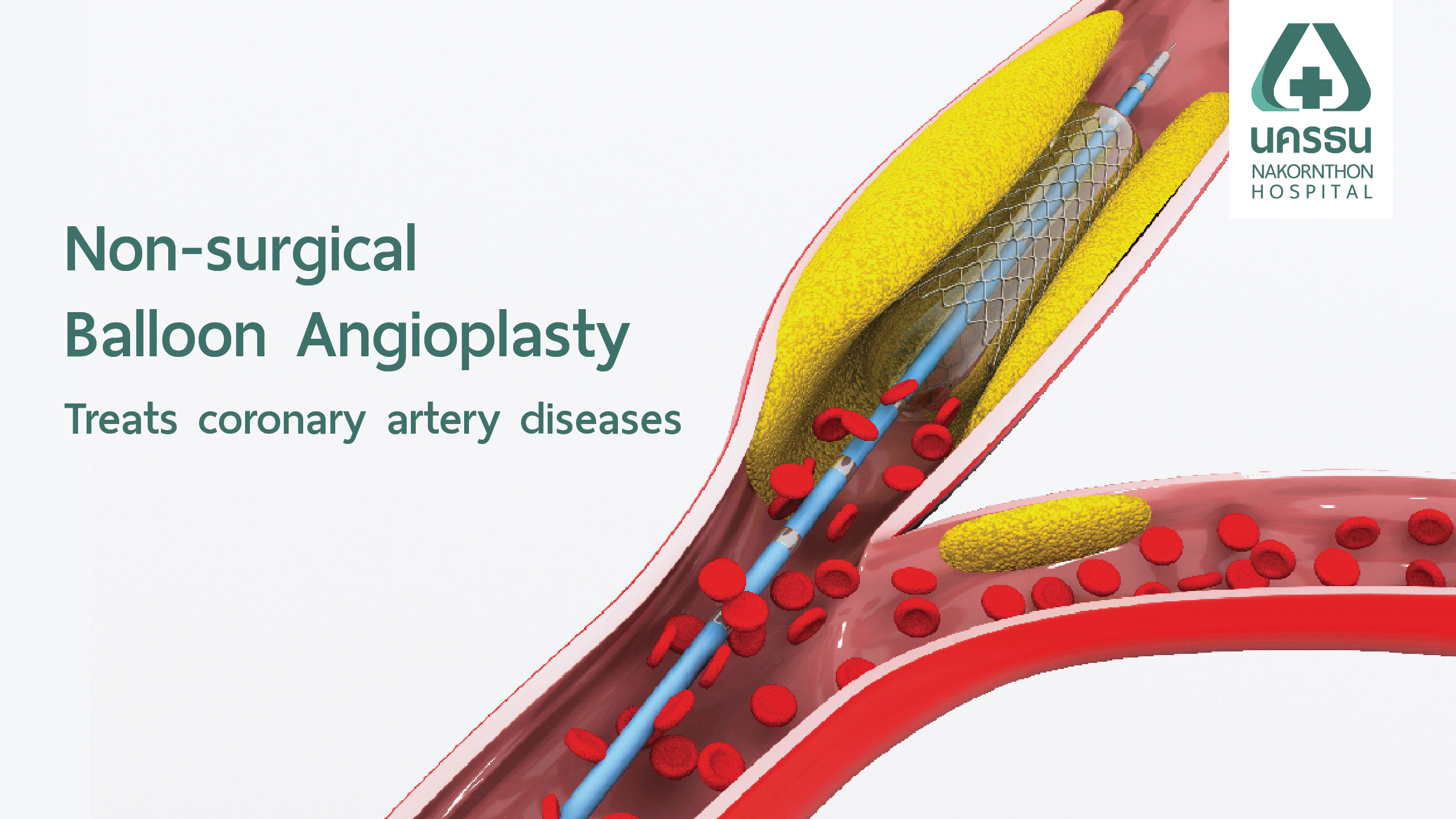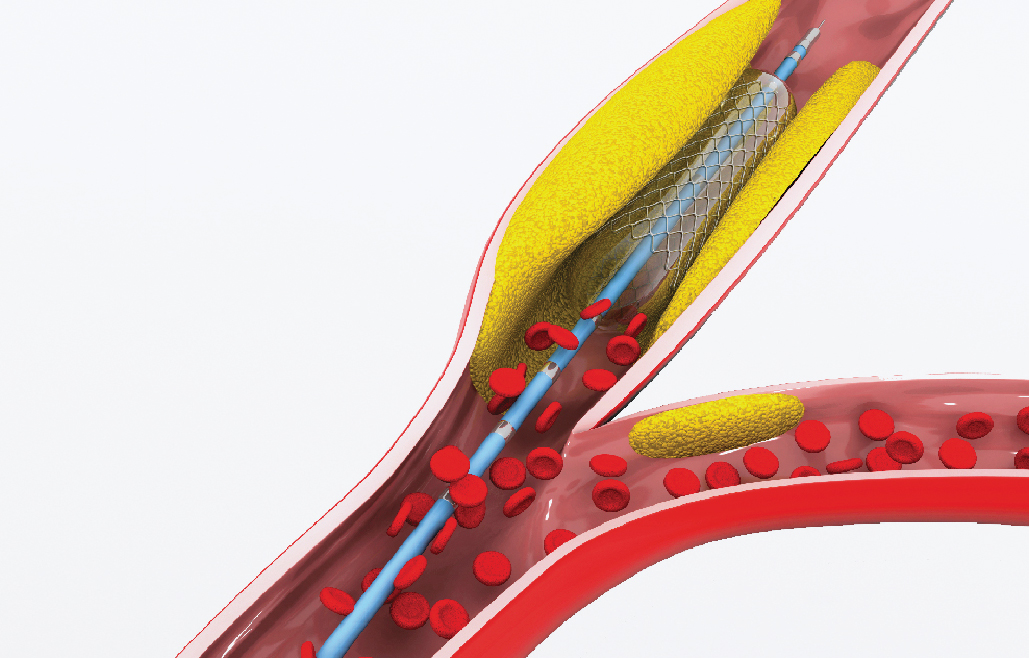Balloon angioplasty to treat coronary artery disease conveniently and safely without surgery
Center : Heart Center
Article by : Dr. Sirapat Poonvutikul

Current approaches to treating heart disease have several methods. This also depends on the type of heart disease. It usually consists of lifestyle modifications, medication, surgery, and treatment methods that are popular without surgery. Such as heart injection coronary artery catheterization. This will help to expand the coronary arteries by using a balloon. Many heart patients may be worried and have questions that arise in their minds. Is it a good idea to choose a coronary artery catheterization treatment? Is it safe? Today we bring answers from Nakornthon Hospital Heart Center to solve your doubts to know that coronary artery catheterization is not as terrifying as you think which has all the useful details as follows.
Choose to read by topic:
- Know how to make a heart balloon
- Benefits of Balloon Angioplasty
- Preparation
- Coronary artery dilation procedure with balloon and stent
- Biplane, an innovation in treating coronary artery disease with a coronary balloon
- After Balloon Angioplasty
- Complications in balloon angioplasty:
- Online Consultation
Know how to make a heart balloon
Balloon Angioplasty is a procedure to expand the coronary arteries with cardiac catheterization. This is a flexible tube that has a tiny balloon at the end of it which is inserted into an artery in the groin or wrist. When it reaches the narrowing area, the balloon is connected to an instrument that will expand the balloon when squeezed, the plaque that clings to the walls of blood vessels collapses and widen the blood vessels to allow blood to flow to the heart muscle well again.
Currently, for heart balloon procedure, doctors may consider inserting a stent that has a mesh-like shape. To support and attach to the narrowed artery wall to strengthen the coronary artery expansion in the position of balloon dilation. This will give more effective treatment results. In some cases, a drug-coated stent may be used instead of a conventional stent to prevent recurrent stenosis of the coronary arteries over time.
Benefits of Balloon Angioplasty
Balloon Angioplasty will help push the fat that clogs the artery closer to the artery wall. This allows the blood to flow through the area that used to be constricted more easily. Reduce the risk of acute myocardial infarction from clogged coronary arteries. The chance of complications is lower than bypass surgery, because there is no need for surgery and general anesthesia. In addition, it takes an average of 1-2 days to be able to return to normal life without having to worry about ischemic heart disease symptoms and can be repeated in case of further narrowing of the coronary arteries occur in the future.
Preparation
- The patient must abstain from food and drink for 6-8 hours.
- The doctor will inquire about drug allergy and seafood allergy, congenital disease, and physical examination of the patient.
- If the patient has medication that is taken regularly, such as diabetes drugs, especially drugs that dissolve blood clots, inform your doctor and bring your medications.
Coronary artery dilation procedure with balloon and stent
- Your doctor will inject a local anesthetic before puncturing an artery in your wrist or groin.
- Your doctor will insert a soft plastic tube about 2 millimeters in diameter into the artery to pass through the coronary catheter into the aorta of the heart.
- Then contrast is injected or opaque solution, allowing you to see inside the blood vessel where there is a narrowing.
- When found at the point where the blood vessels are narrowed the doctor will insert a cardiac catheter. To dilate narrowed blood vessels with balloons and stents, it takes about 45 - 60 minutes to complete the procedure. The tube in the groin or wrist is pulled out and pressure is applied on the needle puncture site. A medication is also given to stop the bleeding or using devices to help the bleeding stop faster depending on the case and the opinion of the doctor performing the procedure.
Biplane, an innovation in treating coronary artery disease with a coronary balloon
It also increases the efficiency of heart balloon procedures or expanding the coronary arteries with a balloon (Balloon Angioplasty) using an X-ray machine for diagnosing and treating coronary artery disease in two planes or biplane (Biplane DSA) to help in the examination and treatment of coronary artery disease, the biplane machine can image the blood vessels in two planes at the same time: front and side. The resulting images are therefore clear. This allows the doctor to clearly see the very small catheters. It's like seeing a 3D image, making it possible to treat complicated coronary artery disease and coronary artery disease.
After Balloon Angioplasty
- You must lie down for at least 6 to 10 hours after the procedure.
- In the case of injecting color through the groin- After this is done, the catheter will be pulled out and apply pressure on the groin area for about 15 minutes without stitches. The patient must lie down and avoid bending in the groin for 6-10 hours, unable to sit up or walk immediately.
- In the case of injecting color through the wrist - This method is suitable for patients who are overweight, very obese, or have peripheral artery stenosis. Using a recovery period of 4-8 hours. After the treatment is done, you can get up, sit or stand right away. Only the wrist strap (TR band) is inserted, but it can be removed.
- During this time, you should drink about 1 liter of water if there are no restrictions on drinking to drive contrast medium out of the body.
- Take care of the wound area. Keep it dry for about 3 days, if it gets wet, use betadine to wipe the wound area.
- Observe the location of the area where the procedure is performed. If there is bleeding, pain, swelling, redness, heat or cold, pale, or clots, inform the ward nurse immediately.
- If there is pain in the wound area, take painkillers medications or consult a doctor.
- Take the medications continuously, do not stop taking the medication on your own. If you notice any abnormal symptoms such as chest pain, see a doctor immediately.
- Refrain from strenuous activities or exercise during the first 2 weeks.
- Do not lift anything heavier than 5 kg for approximately 1 month after the cardiac catheterization procedure.
- If coughing or straining press the wound area. Approximately 7 weeks after cardiac catheterization procedure (in the case of groin area)
Complications in balloon angioplasty:
There is a small 1% risk when doing this procedure. The risk conditions for balloon angioplasty surgery may include the following:
- Infection, bleeding, or pain where the catheter is inserted.
- Blood clots form in the coronary arteries causing myocardial infarction.
- Hypersensitivity to contrast agents, shock may occur.
- Arrhythmia
- Some people may develop coronary artery disease or perforation of the heart muscle during the insertion of a balloon tube into the vein.
- A blood clot in the brain occurs. (Incident less than 0.2%)
- Fatal (incidence less than 0.5%)
Balloon Angioplasty is done under the supervision of a medical professional, together with interventionist to help reduce the risk.
For those who are interested or need more information in regards balloon angioplasty, Nakornthon the Heart Center is ready and has a team of specialist and medical personnel to support, provide advice and assistance.



.jpg)

